 Loading... Please wait...
Loading... Please wait...Wood Veneer Tutorials
Wood Veneer How-To Videos
A Beginner's Guide To Veneering
A Beginner's Guide To Veneering
By Bob Morgan, Pres., Veneer Factory Outlet.com
Veneer Is Real Wood
What is a wood veneer? A wood veneer is just a thin slice of wood from a wooden log.
Most of our veneers are bonded to a paper back or a wood back. The paper backed veneers are about 1/64" thick overall. The wood backed veneers are about 3/64" thick overall.
How We Make Our Veneer Sheets
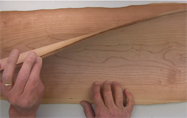
Here is how we make large sheets of wood veneers using the smaller sheets of veneer that are sliced from a log:
We start with "raw" sheets of veneer such as the ones pictured here. The raw sheets are sliced off of the face of a log using a veneer slicing machine. A typical sheet of "raw" veneer could be 4" to 15" wide and the same length as the log.
The raw sheets are kept in the same sequence that they were sliced from the log. The sheets are clipped along the edges to make them perfectly straight and parallel.
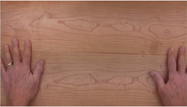
We flip every other sheet upside down. This causes the grain patterns from one sheet to the next to match in a mirror image when the sheets are placed side by side. This is called a book match.
We splice the sheets side by side using a veneer splicing machine to make larger, wider sheets. The larger veneer sheets, are then squared up and bonded to either a paper back or a wood veneer back.
Most of the types of veneers that we sell are:
- 1/64" Paper Backed
- 3/64" Wood Backed
- Both of the above can be ordered with our optional 3M peel and stick adhesive
Paper Backs Or Wood Backs Add Strength And Stability
In order to give the veneer sheets more strength and stability, we bond them permanently to either a paper back or a wood veneer back. For shipping, we roll these veneers and send them in a cardboard box.
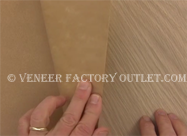
1/64" Paper Backed Veneers
The paper backed veneers are thin and flexible, especially when you bend them with the grain. This bendability might come in handy if you are trying to bend your veneer around a corner or if you have a concave or convex surface that you are working with.
The paper back is a tough, strong, 10 mil paper that is permanently bonded to the wood veneer. The paper side is the side that you glue down. The paper backed veneers can also be ordered with the optional 3M peel and stick adhesive.
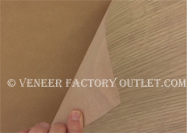
3/64" Wood Backed Veneers
The 3/64" wood backed veneer is also called "2 ply veneer" because it is made using 2 sheets of veneer that are glued back to back.
The only differences between the 1/64" paper backed veneers and the 3/64" wood backed veneers are the thickness, and the type of back. The extra thickness of the wood backed veneers, coupled with the wood construction of the back, give added strength and stability.
The wood backed veneers can be ordered with the optional 3M peel and stick adhesive. They can be cut with a razor knife or a scissors.
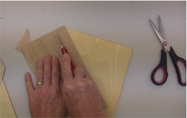
Wood Veneers Can Be Cut With A Razor Kinfe Or A Scissors
You can cut the paper backed veneers with a utility knife or a scissors. For most surfaces, you cut the veneer larger than the area that you are going to veneer. Then, you glue the veneer down and you trim around the edges with a razor knife to get an exact fit.

Optional 3M Peel And Stick Adhesive
You can order your paper backed or wood backed veneers with an optional 3M peel and stick adhesive. You just peel off the release paper and stick the veneer down to any clean and smooth surface that has been painted or finished. The 3M peel and stick veneers lay down real flat, real easy, and real fast.
We have been selling the 3M peel and stick adhesive backed veneers since 1974 and our customers love them. There is no mess, no fumes and no clean up.
2 Common Gluing Methods For Wood Veneers
In addition to the peel and stick option mentioned above, there are 2 common methods of gluing the paper backed and the wood backed veneers.
- Use Carpenter's glue, such as Titebond 2, and clamps
- Use 2 coats of contact cement on each surface
I have prepared a video and I have also prepared another tutorial that goes into more detail of how to glue down a wood veneer. For the purposes of this tutorial, I'll give you a quick run through of these two common gluing methods.
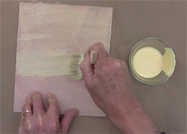
Gluing Wood Veneer With Carpenter's Glue
When you use woodworker's glue, such as Titebond 2, you apply the woodworker's glue to the veneer and also to the surface that you are veneering. You position the veneer in place and you sandwich the work between 2 flat boards. Apply pressure with clamps and let dry for 24 hours.
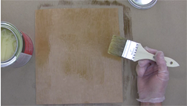
Gluing Wood Veneer With Contact Cement
When using contact cement, use 2 coats of contact cement on each surface. Let the contact cement dry between coats. It takes about 30 to 60 minutes for each coat to dry. When the second coat is dry, you lay the veneer in place and you apply pressure with a wallpaper seam roller. Work in a well ventillated area that is't humid and at an ambient temperature above 60 degrees Fahrenheit.
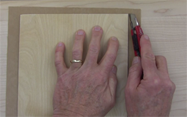
Trim Off The Excess Veneer For An Exact Fit
To get an exact fit, you cut the sheet of veneer about a half inch larger on all sides than the area that you are veneering. Then, when the veneer is glued down, you trim off the excess with a razor knife.
For areas that are inset, such as an inset panel of a door, you will cut the veneer ahead of time to the exact size and you will take care when you lay it in place so that it fits perfectly.
Paper Backed Veneer Vs. Wood Backed Veneer - Pros And cons
So, which is better - paper backed veneer or wood backed veneer? Actually, you can usually use either one for most projects. In some situations, such as when you have a curved surface, the paper backed veneer may be your best choice.
Sometimes, wood backed veneer is the only way to go - and this would be when you need the extra thickness to reduce any telegraphong through the veneer from an uneven surface, for example. The wood backed veneers are also the best choice for surfaces, such as table tops, that get lots of wear and tear.
If you use contact cement for you adhesive, some types of finishes, such as lacquer especially if thinned down and sprayed, might soak through a paper backed veneer and attack the contact cement. This doesn't happen often, but if you want an added margin of safety, we recommend that you use a wood backed veneer.
Our customers use both the paper backed and the wood backed veneers with success. Some of our customers use the paper backed veneers exclusively and some customers prefer the wood backed veneers.
I prefer the wood backed veneers. They are sturdier, flatter, easier to use, and more forgiving. They eliminate problems with seep through of finishes and they reduce or eliminate the telegraphing of defects from the substrate. I think that the wood backed veneers give an added margin of safety, even when the craftsman makes some mistakes.
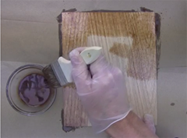
Stain And Finish A Wood Veneer The Same Way You Would Stain And Finish Any Wooden Surface
All of our paper backed veneers and wood backed veneers are pre sanded at the factory, so sanding isn't usually necessary. For finishing, you apply a stain or a finish to our veneers the same way that you would apply a stain or a finish to any wooden surface.
Check out our other tutorials and videos for more instructions about wood veneers and veneering and finishing techniques.
Bob Morgan, Pres., Veneer Factory Outlet.com















